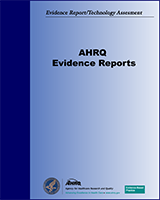This publication is provided for historical reference only and the information may be out of date.
Criteria for Determining Disability in Infants and Children: Short Stature
Evidence Reports/Technology Assessments, No. 73
Authors
Patricia Wheeler, MD, Investigator, Ethan Balk, MD, MPH, Project Leader, and Cynthia Cole, MD, MPH, Coordinating Team Leader. Investigators: Karen Bresnahan, MD and Barbara Shephard, MD. EPC Staff: Joseph Lau, MD, Director, Deirdre DeVine, MLitt, Project Manager, Mei Chung, MPH, Research Associate, and Kimberly Miller, BA, Research Assistant.Structured Abstract
Objectives:
The evidence report provides a systematic review of the scientific evidence to answer three questions of whether short stature in a child 1) due to a medically determinable cause or 2) due to skeletal dysplasia may be associated with disability, and 3) whether decreasing growth velocity in a child with a chronic disease may serve as an indicator of severity of the disease.
Search Strategy:
Systematic searches were performed for relevant articles in MEDLINE® from 1966 through February 2001, with updates through October 2001. Additional studies were identified from other databases, reference lists of review and primary articles, and from domain experts.
Selection Criteria:
Eligibility criteria for study inclusion included: primary articles reporting original data on at least 10 children; in studies of children with short stature, data on association between height and functional ability or limitation; in studies of children with chronic diseases, association between a measure of severity of disease and either height or height velocity. Studies could be cross-sectional or longitudinal, prospective or retrospective, comparative or not.
Main Results:
A total of 13,537 English language citations were reviewed. Of these, 825 articles were reviewed for inclusion. For Question 1, 31 studies met inclusion criteria; for Question 2, 31 studies; and for Question 3, 53 studies. Detailed data extraction was performed on these 115 studies.
Based on the reviewed articles, no severe functional limitations were found in children with short stature due to isolated short stature, growth hormone deficiency, multiple hormone deficiency, Turner syndrome, or Russell-Silver syndrome. The studies reviewed focused on intelligence, academic achievement, behavior, visual-motor perception, and psychomotor development. In each of these categories, children with short stature either had testing that was not significantly different from the controls or from the population mean, or if the testing were significantly poorer, it was generally within 1 standard deviation (SD) of the population mean.
Based on the articles reviewed, children with skeletal dysplasias were not at increased risk of having severe impairments in intelligence, academic achievement, or psychological outcome. There was an increased risk for delay in achievement of motor skills in children with achondroplasia and osteogenesis imperfecta, and decreased ambulation, range of motion and mobility in children with more severe forms of osteogenesis imperfecta. The results for hearing impairment, respiratory dysfunction and spinal curvature appear to indicate an increased risk for impairment in these three areas, but the studies were limited in the number of children evaluated and how the samples were selected.
The evidence from four conditions (congenital heart disease, juvenile rheumatoid arthritis, Crohn's disease and human immunodeficiency virus (HIV) infection) appear to indicate that a sustained decrease in linear growth velocity can be used as a marker of the severity of these underlying conditions. Evidence is less clear for astham, atopic dermatits, diabetes, ß-thalassemia, and chronic kidney disease. There was only one study each for sickle cell disease, congenital adrenal hyperplasia and cerebral palsy so it is difficult to draw conclusions for these conditions. No study addressed whether the process of having a decreasing height velocity was likely to be disabling.
Conclusions:
No severe functional limitations were found in children with short stature due to growth hormone deficiency, multi-hormone deficiency, Turner syndrome, Russell-Silver syndrome or isolated short stature. These children generally scored within 1 SD of the population mean. Children with skeletal dysplasias were not at increased risk of having severe impairments in intelligence, academic achievement, or psychological outcome. Sustained decrease in linear growth velocity has been shown to be associated with the severity of congenital heart disease, juvenile rheumatoid arthritis, Crohn's disease, and HIV.
Prepared for: Agency for Healthcare Research and Quality, U.S. Department of Health and Human Services.1 Contract No. 290-97-0019. Prepared by: Tufts-New England Medical Center EPC, Boston, MA.
Suggested citation:
Wheeler P, Balk E, Cole C, et al. Criteria for Determining Disability in Infants and Children: Short Stature. Evidence Report/Technology Assessment No. 73 (Prepared by Tufts-New England Medical Center Evidence-based Practice Center under Contract No. 290-97-0019). AHRQ Publication No. 03-E025. Rockville, MD: Agency for Healthcare Research and Quality. March 2003.
This report may be used, in whole or in part, as the basis for development of clinical practice guidelines and other quality enhancement tools, or a basis for reimbursement and coverage policies. AHRQ or U.S. Department of Health and Human Services endorsement of such derivative products may not be stated or implied.
AHRQ is the lead Federal agency charged with supporting research designed to improve the quality of health care, reduce its cost, address patient safety and medical errors, and broaden access to essential services. AHRQ sponsors and conducts research that provides evidence-based information on health care outcomes; quality; and cost, use, and access. The information helps health care decisionmakers—patients and clinicians, health system leaders, and policymakers—make more informed decisions and improve the quality of health care services.
The authors of this report are responsible for its content. Statements in the report should not be construed as endorsement by the Agency for Healthcare Research and Quality or the U.S. Department of Health and Human Services of a particular drug, device, test, treatment, or other clinical service.
- 1
2101 East Jefferson Street, Rockville, MD 20852. www
.ahrq.gov
